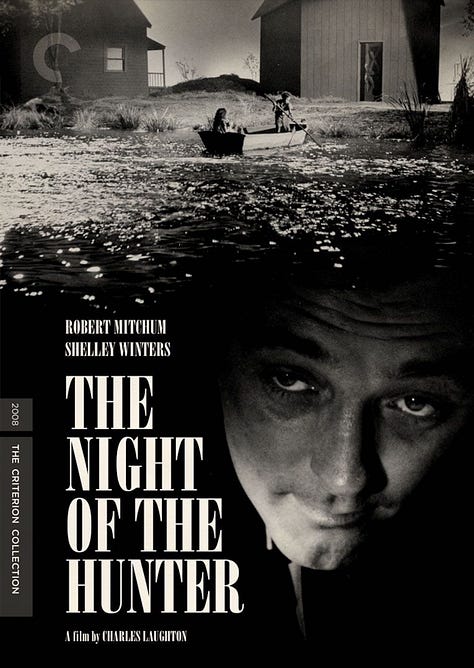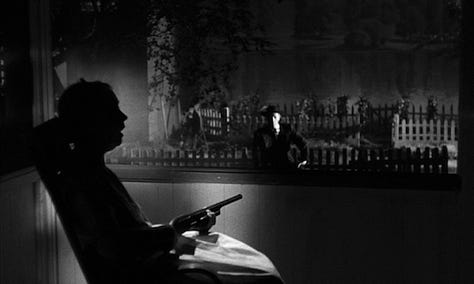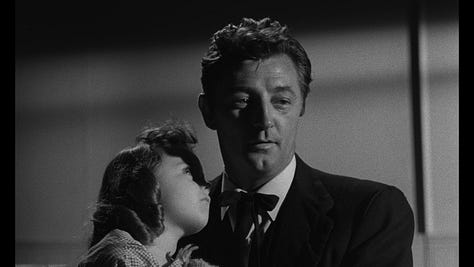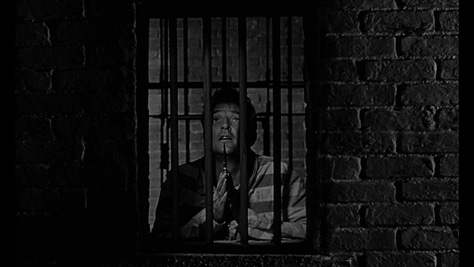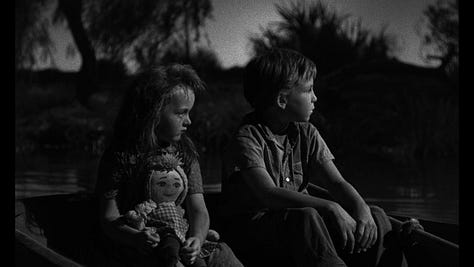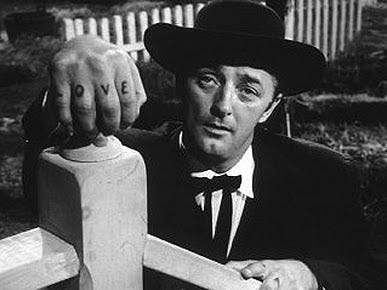THE NIGHT OF THE HUNTER
1955 • Charles LaughtonScreenplay: James Agee; Based on The Night of the Hunter 1953 novel by Davis Grubb
Cast: Robert Mitchum, Shelley Winters, Lillian Gish, James Gleason, Evelyn Varden, Peter Graves, Don Beddoe, Gloria Castillo, Billy Chapin, Sally Jane Bruce
Cinematography: Stanley Cortez
Music: Walter Schumann
Producer: Paul Gregory
United Artists
Would you like me to tell you the little story of right-hand/left-hand? The story of good and evil?
Set against the Great Depression. The Night of the Hunter follows Harry Powell (Robert Mitchum), a sinister and charismatic preacher with a hidden agenda. Powell marries a vulnerable widow named Willa Harper (Shelley Winters) in order to gain access to her late husband's hidden fortune. The only people who know the money's location are Willa's two children, John (Billy Chapin) and Pearl (Sally Jane Bruce). As Powell's true intentions are revealed, the children are forced to flee from their home to escape his clutches. They embark on a journey down the Ohio River, pursued relentlessly by Powell.
The Night of the Hunter functions as a Brother Grimm-esque fairy tale with the malevolent preacher, Harry Powell, playing the part of the Big Bad Wolf. Powell represents the embodiment of evil, preying on the vulnerable like a wolf lurking in the dark woods. His deceptive charm and manipulative tactics echo the cunning nature of traditional fairy tale villains. The film becomes a cautionary tale, warning against complacency and urging viewers to see beyond the surface of societal constructs.
Taking place during the Great Depression the film exposes the harsh realities that existed beneath the facade of the American Dream. Powell's preacher, with his hypocritical religious fervor and predatory instincts, critiques the dangers of blind faith and false morality. The film challenges the notion of an inherently moral and righteous society. It questions the very foundations upon which the idea of an idealized America is built, revealing the vulnerability of individuals, especially children, in the face of seemingly benevolent figures.
Robert Mitchum’s portrayal of the con man and prison-escaped preacher Harry Powell is nothing short of captivating and intimidating. Mitchum's performance adds layers of complexity to the character, rendering Powell as more than just a typical villain. His ability to seamlessly switch between charming folksy charisma and bone-chilling menace creates a character that lingers in the minds of the audience. Mitchum's presence on screen is instrumental in establishing the film's tension and suspense. Powell's false piety and persuasive charm make him eerily dependable, drawing viewers in before revealing his true, terrifying nature. Mitchum's deep, gravelly voice and intense gaze further emphasize Powell's intimidation factor. His subtle facial expressions and calculated gestures convey a quiet malevolence that is both captivating and terrifying. Mitchum's nuanced performance makes Powell's predatory pursuit of the children all the more chilling, as he becomes a relentless force of evil.
The supporting cast members contribute significantly to the film. Shelley Winters, in her role as the widow Willa Harper, embodies vulnerability and naivety, making her a tragic character. Winters skillfully portrays Willa as a woman yearning for love and stability, which ultimately makes her susceptible to the manipulations of Harry Powell. Her fragility contrasts starkly with the menacing presence of Powell. Winters' ability to convey Willa's desperation and hopelessness adds emotional weight to the character, making her fate all the more heartbreaking.
Lillian Gish, as the saintly and resilient Ms. Cooper, is a beacon of hope in the film. She is the angel to Powell’s devil, embodying unwavering goodness and maternal strength. Gish is both tender and fierce. She is a symbol of protection and stability for the orphaned children, offering them safety and love in a world filled with danger. Gish's performance radiates kindness and wisdom, the antidote to Powell’s poison.
Charles Laughton, in his directorial debut (and farewell) is nothing short of a master, transforming the black and white rural landscape into a haunting and mesmerizing southern-gothic fairytale. Laughton imbues the film with a suffocating sense of danger. He crafts a world where light and shadow play vital roles in shaping the film's atmosphere and enhancing its thematic depth. Cinematographer Stanley Cortez employs the use of chiaroscuro lighting, with its stark contrast between light and dark, to create a visually striking backdrop. The deep shadows and intense highlights not only add a sense of visual richness but also mirror the moral dichotomy at the heart of the story. This is the story of right hand/left hand… the story of good and evil. The idyllic countryside scenes are bathed in soft, ethereal light, portraying moments of innocence and purity. In contrast, the shadows loom ominously when Harry Powell is on screen, casting him into a sinister shadow that accentuates his menace.
The film's pacing also plays a crucial role in establishing its ominous tone. The deliberate pacing allows moments to linger, creating a sense of anticipation that something dreadful is about to occur. It gives the audience time to absorb the atmosphere, building a psychological tension that keeps viewers on edge throughout the film.
The rowboat sequence in The Night of the Hunter stands as perhaps the most chilling in the film, creating an atmosphere of surreal horror and dread. As John and Pearl embark on their perilous journey down the river, the imagery in this sequence is laden with symbolic meaning, heightening the emotional impact and leaving a lasting impression on the audience. The river journey itself serves as an odyssey. The spider webs, perhaps represent a cunning spider (Powell) setting traps for his prey. The scene has a nightmarish quality, intensifying the children's vulnerability and the audience's sense of impending doom. Or perhaps the river is meant to represent Powell. It is, after all, a powerful and unpredictable force of nature.
Laughton, despite proving his incredible directorial talent in The Night of the Hunter, never directed another film. The Night of the Hunter (bafflingly) received mixed critical and commercial reception upon its release in 1955. While the film has since gained recognition as a classic, its initial lukewarm reception discouraged Laughton from pursuing more directing opportunities.
It's a hard world for little things.
Notoable Awards & Accomplishments
National Film Registry: Inducted in 1992
Cahiers du Cinéma selected The Night of the Hunter in as the second-best film of all time, behind Citizen Kane
Streaming: Fubo, MGM+, Hoopla, Tubi, DirecTV, Pluto, Watch TCM
Digital Rental/Purchase: Available at most digital retailers
Physical Media: Available on 4K, Blu-Ray and DVD.

